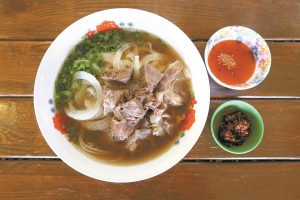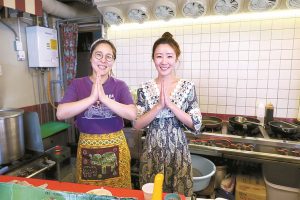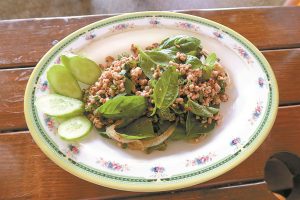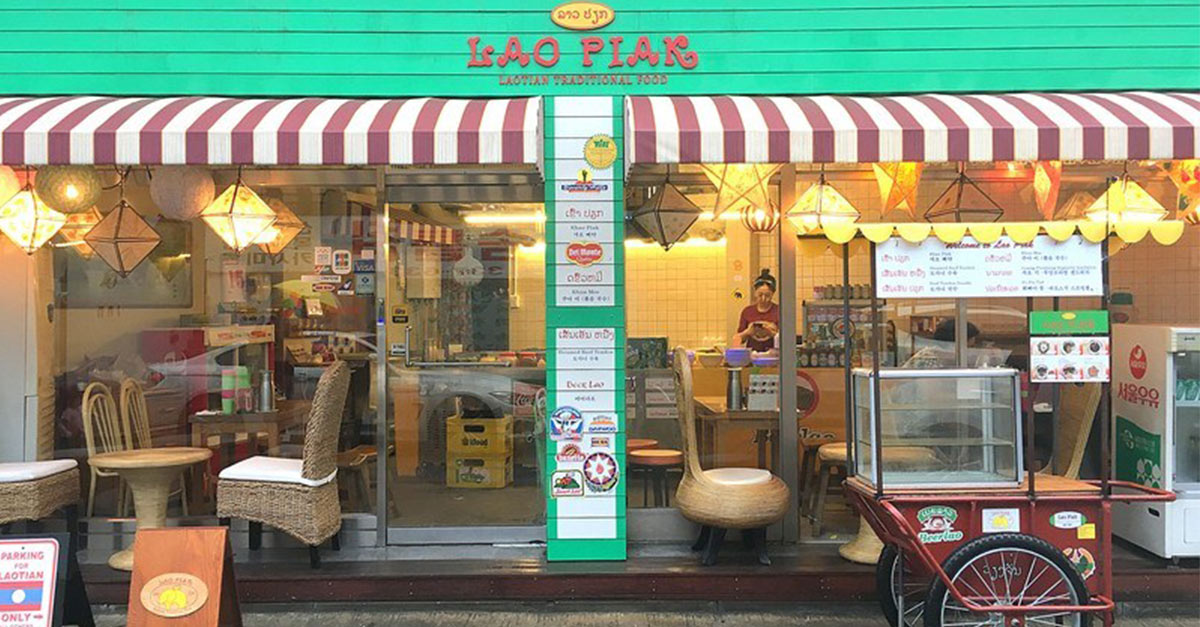Newly opened Lao Piak is one of only 2 Laotian restaurants in Seoul
Two young women in their early 30s have been close friends since college. Both graduated from high school in Korea and went on to the University of Virginia in the United States, where they first met. When they graduated, they both went into television ― one became a TV presenter and the other a producer at major local broadcasters.
They prepared for the TV jobs together and kept in close touch and traveled together when they started working. After five years in their respective positions, they both quit.
Kicking their established jobs to the curb, the two women set out on a completely new, risky adventure to open a Laotian restaurant called “Lao Piak” on a tranquil street in Mangwon-dong, Mapo-gu, Seoul. One year into its opening, the restaurant is a success.

It all began when the two went on vacation together two years ago to Laos, a country that had been gaining hype on television.
“We went to Vientiane and Luang Prabang in Laos. It was our first time in the country. We decided on Laos because it was close to Thailand and Vietnam and had similar food. It was also after Flowers Over Youth ended with its episode on Laos. That triggered our interest,” said Chung Hyo-yeol, co-owner of Lao Piak and the former TV presenter. Piak refers to noodles in soup in Laotian.
“After traveling to Laos, we were mesmerized by the country and wanted to introduce Laotian cuisine in Seoul. Three months after the trip, we both quit our jobs and went back to Laos to learn Laotian cuisine from locals. On that trip we included Vang Vieng to the two previous locations and stayed for a month.”
They ended up spending three months in the country on three return trips to learn local recipes.
“It was difficult to find locals in the city to teach us the recipes. They were wary. But those in the countryside were more open. Our recipes are from them,” said Won Sung-hoon, co-owner of Lao Piak and former producer at Olive, a local lifestyle and food cable channel.

The two’s radical transformation from producer and presenter to chef-owners brought resistance from their families.
“Mine wouldn’t see me until the restaurant opened. Sung-hoon and I are as close as sisters so we decided to live together above the restaurant. It’s less tiring for us,” said Chung.
“My family is used to my radical transformation due to a past experience _ when I switched from a biology major to becoming a producer. When they heard I was planning to open a restaurant, they were less surprised,” said Won.
Laotian food is much influenced by neighbors Thailand and Vietnam and vice versa. It also uses a lot of ingredients from the neighboring countries. Laotian staples are steamed sticky rice and larb which is a spicy marinated meat or fish mixture. The papaya salad dish, better known as som tam in the West, is also a Laotian invention.
“Because of the low quality of beef in Laos due to geographical reasons, they use more pork and chicken. Their noodle soup is popular among Koreans. The noodles are made with glutinous rice, but it’s not the same as rice noodles in Korea. There’s a dish called khao piak which is popular. Khao means rice, and piak is noodle soup,” said Won, who is in charge of the noodle soup, whereas Chung is in charge of anything fried.
“Our noodles are handmade. We each take turns making them. It’s on limited availability because we can only make a handful by ourselves.”
The two are the only chefs at the restaurant. In the beginning they did everything from cooking to serving. Now they have a few part-time servers to help out.

“Here, we create two types of stock ― beef and chicken. We tried for three months to get this right,” said Chung.
What they learned in Laos is that they like spicy food, contrary to Vietnamese or Thai.
“We were surprised how much chili sauce they put in the soup ― until it’s red. So we created our own chili sauce,” said Won. “We also want to introduce a dish called Khao poon, a rice vermicelli soup, mostly eaten at weddings. They use coconut milk and ox blood. It might not be liked by Koreans, but we want to introduce foods like this.”
The two didn’t do any marketing but people line up to get a bite. The Laotian Embassy in Korea became a big fan. A contributing factor is the style and decor of the restaurant, which the two put a lot of legwork into.
“We brought in almost everything from Laos ― plates, accessories and decorations and planned the interior concept,” said Chung.
Luckily it caught people’s eyes who were passing by. The street is rather remote from the central hip region, which is why it is surprising that it would attract so many people.
“A lot of locals started paying visits and now weekdays are packed with locals and weekends with young people from elsewhere.”
Here are some pictures from Lao Piak’s Official Instagram Page.
[ngg_images source=”galleries” container_ids=”32″ display_type=”photocrati-nextgen_basic_thumbnails” override_thumbnail_settings=”1″ thumbnail_width=”100″ thumbnail_height=”75″ thumbnail_crop=”1″ images_per_page=”20″ number_of_columns=”0″ ajax_pagination=”0″ show_all_in_lightbox=”0″ use_imagebrowser_effect=”0″ show_slideshow_link=”0″ slideshow_link_text=”[Show slideshow]” template=”/home/www/wp-content/plugins/nextgen-gallery/products/photocrati_nextgen/modules/ngglegacy/view/gallery.php” order_by=”sortorder” order_direction=”ASC” returns=”included” maximum_entity_count=”500″]


